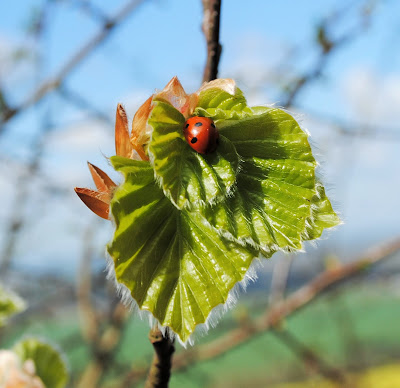It's no secret that I have a bit of a thing for Yoesden and visit a lot. Today was the last sunny day in the forecast for a few days, so I was looking forward getting out there and seeing what surprises I could find.
As usual, the view was breath taking, but today it was extra special as everything was edged with the frilly white lace of the blackthorn blossom.
I sat on an ant hill and waited hopefully for the green hairstreak butterflies to appear, but sadly they were nowhere to be seen today. I saw them there last year on the
21st April, on a sunny day that was very similar to today. Seems like it's still a bit early for them this year though and the cold weather that's on the way won't help. It's funny that earlier in the year I was worried that the mild winter was causing havoc and making spring happen too early. It feels like mother nature has sorted things out though and many things are actually a little bit behind last year.
Sitting on my ant hill, I wasn't disappointed though as I soon realised that the blackthorn was alive with all sorts of bees, flies and even the occasional butterfly. Everything looked so pretty feeding on the beautiful flowers in the spring sunshine.
 |
| Comma |
 |
| Peacock |
 |
| Peacock |
It wasn't only the insects that were enjoying the blackthorn. I watched a blue tit for several minutes that was having a wonderful time in amongst the flowers.
I saw several little bee flies buzzing around, which was a real treat to see. They're such funny looking things with their furry bodies, big eyes and long proboscis.
The primroses were still flowering well and the cowslips were just starting to bloom.
 |
| Primroses |
 |
| Cowslips |
 |
| Cowslips |
To top off another wonderful visit, half a dozen swallows were swooping over the cow shed and the meadow. Hopefully they'll nest in the shed again this year.
 |
| Look very closely and you might just see a swallow sat on the roof! |
BBOWT recently ran an appeal to raise £150,000 to buy land adjoining the reserve so that they could extend it. A couple of weeks ago it was announced that they'd reached their target, from public donations and a couple of grants, and the additional land could be purchased. This includes 4 acres of chalk grassland, 1.5 acres of woodland and 3 acres of pony paddocks. Brilliant news for a brilliant site!
 |
The new land includes the pony paddocks (bottom right), woodland behind
the 'hole in the woods' (the grass area between the two areas of woodland)
and an area of chalk grassland beyond that |
Back at home, I saw my first holly blue of the year in the back garden yesterday and the first orange tip today. Feels like the butterflies are on their way at last!























































